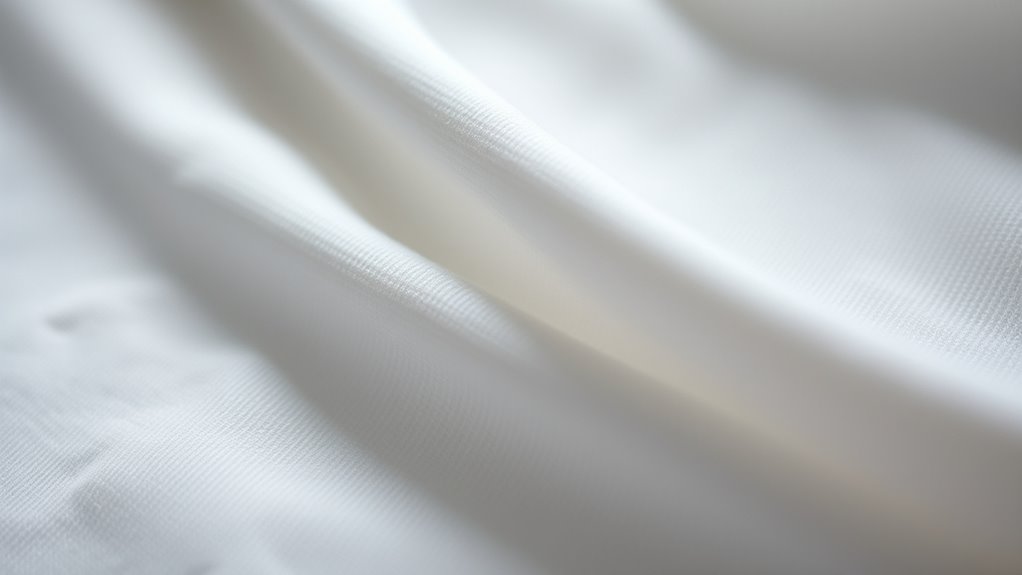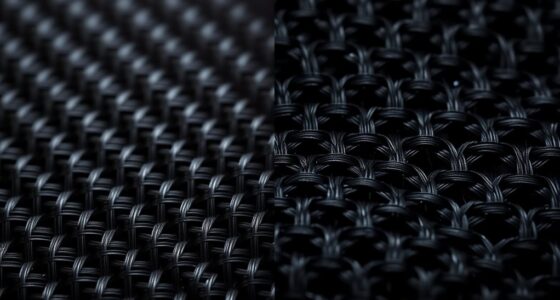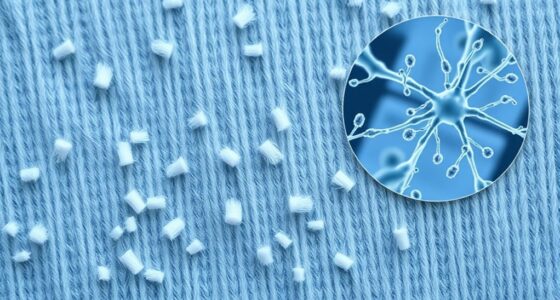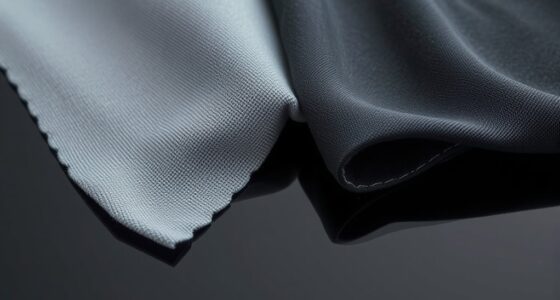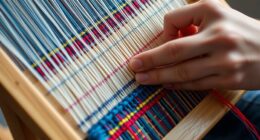The secret to super-soft T-shirt cotton lies in the physics of fiber elasticity and precise manufacturing processes. When fibers are naturally elastic and properly aligned, they move smoothly and reduce friction, making the fabric feel incredibly gentle. Techniques like combing and mercerization enhance these qualities, ensuring the fibers resist stiffness and stay plush over time. Keep exploring to uncover how these science-backed methods create that luxurious softness you love.
Key Takeaways
- Fiber elasticity allows cotton fibers to stretch and recover, reducing roughness and enhancing fabric softness.
- Processing techniques like mercerization and combing improve fiber alignment, resulting in smoother, more comfortable T-shirts.
- Highly elastic fibers minimize friction between fibers, creating a plush, luxurious feel in the fabric.
- Proper fiber length and alignment during manufacturing produce stronger, softer yarns with enhanced tactile properties.
- The combination of fiber elastic properties and advanced processing transforms ordinary cotton into super-soft, durable T-shirt fabric.
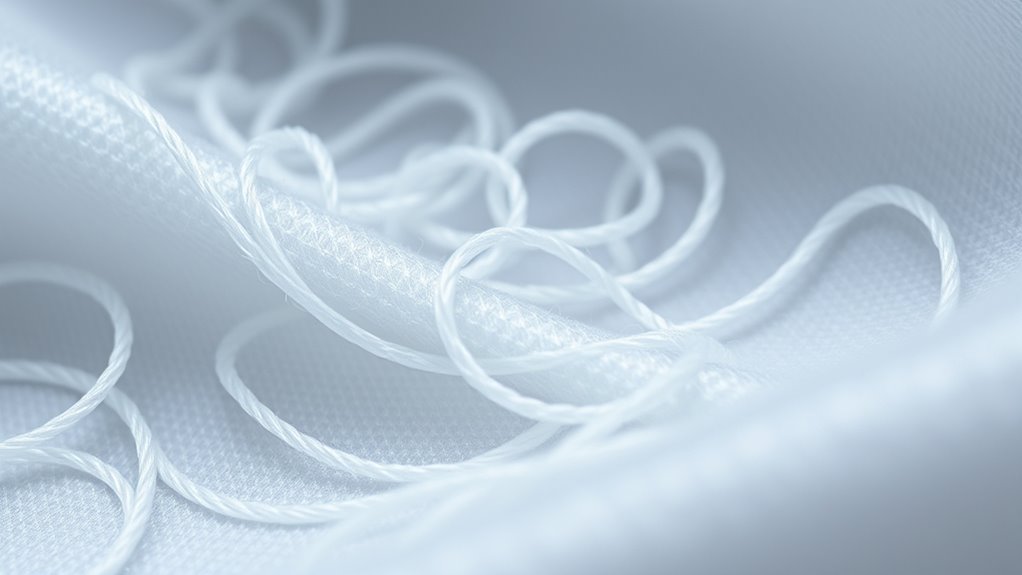
If you’ve ever wondered what makes some T-shirts feel incredibly soft against your skin, the secret lies in the physics of the cotton fibers. It’s not just about the quality of the cotton, but how its fibers are structured and behave on a microscopic level. The key factors influencing fabric softness are fiber elasticity and the way the fibers are processed during manufacturing. When cotton fibers possess high elasticity, they can stretch and bend more easily without breaking, which results in a smoother, more flexible fabric that feels gentle and luxurious against your skin. This fiber elasticity allows the fabric to recover its shape quickly after stretching, preventing stiffness and maintaining a soft texture over time.
The physical properties of cotton fibers are what give rise to this fabric softness. Cotton fibers are naturally curved and somewhat elastic, but through specific processing techniques—like combing, carding, and mercerization—you can enhance their qualities. Combing aligns the fibers more uniformly, reducing roughness and creating a smoother surface. Mercerization, in particular, involves treating the fibers with a caustic solution, which increases their luster, strength, and elasticity. These treatments help the fibers become more pliable, which directly translates into a softer, more comfortable fabric. When fibers are highly elastic, they also resist creating harsh, rigid textures that can feel rough or coarse.
Understanding the physics behind fiber elasticity reveals why some T-shirts feel softer even if they’re made from the same type of cotton. It’s not just the fiber length or purity but how the fibers respond to stress and how they’re aligned during spinning and weaving. Longer fibers tend to produce stronger, smoother yarns, but if those fibers are also highly elastic, your T-shirt will feel softer and more luxurious. The elasticity allows the fibers to move and bend naturally, reducing friction between fibers and creating that plush, gentle sensation you crave.
Highly elastic cotton fibers create softer, more luxurious T-shirts by reducing friction and enhancing natural movement.
In essence, the combination of fiber elasticity and meticulous processing techniques is what transforms ordinary cotton into super-soft T-shirts. These scientific principles ensure the fabric is not only more comfortable but also durable and resistant to pilling. So next time you run your hand over a particularly soft T-shirt, remember that the secret physics of cotton fibers—especially their elasticity—are at work, making your clothing feel like a second skin.
Frequently Asked Questions
How Does Cotton Fiber Structure Influence Softness at a Microscopic Level?
You might notice that cotton feels soft because of its fiber structure. At a microscopic level, higher fiber crystallinity means more ordered regions, which makes fibers smoother and softer. Fiber elasticity also plays a role, allowing fibers to bend easily without breaking, enhancing comfort. Together, increased crystallinity and flexibility create a gentler, more luxurious feel, making your T-shirt extra soft and pleasant against your skin.
What Role Does Moisture Content Play in the Perceived Softness of T-Shirt Cotton?
Ever wonder what makes your T-shirt feel irresistibly soft? Moisture content plays a vital role, acting like a hidden secret. When cotton absorbs moisture during fabric dyeing or chemical treatments, fibers swell slightly, reducing friction and enhancing softness. Too dry, and the fabric feels rough; too moist, and it becomes limp. You can access this softness by controlling moisture levels, ensuring your shirt remains cozy and smooth with every wear.
Can Environmental Factors Alter the Physical Properties of Super-Soft Cotton?
Environmental factors can definitely alter the physical properties of super-soft cotton. Exposure to sunlight, humidity, or pollution can weaken fibers over time, making fabrics less soft or durable. Using eco-friendly dyes and gentle chemical treatments helps preserve cotton’s softness and integrity. To maintain your super-soft T-shirts, store them properly and avoid harsh environmental conditions, ensuring they stay cozy and vibrant longer.
How Do Manufacturing Processes Impact the Fiber Alignment for Maximum Softness?
You can influence fiber alignment through specific manufacturing techniques to maximize softness. During processing, methods like gentle stretching and controlled spinning align the fibers more uniformly, reducing stiffness. By carefully selecting and applying these manufacturing processes, you enhance the fiber alignment, making the fabric feel softer against your skin. Consistent, optimized techniques guarantee the cotton’s natural properties are preserved, resulting in a super-soft T-shirt that’s comfortable and luxurious.
Are There Differences in Softness Between Organic and Conventional Cotton Fibers?
When it comes to softness, you might find that organic cotton often feels gentler, but the real story is in the organic comparison. Organic fibers tend to be less processed, which can enhance fiber durability and maintain a softer touch over time. While both types can be comfy, organic cotton usually offers a more natural, plush feel from the start, making it worth considering if softness and durability matter to you.
Conclusion
Now, as you run your fingers over that ultra-soft T-shirt, remember it’s not just comfort but the hidden physics that make it possible. Imagine the delicate fibers as tiny bridges, seamlessly connecting softness with strength—like a whispered secret between fabric and skin. While it looks simple, beneath the surface lies a complex dance of molecules and tension. So next time you wear it, appreciate the science that transforms raw cotton into your everyday luxury.

